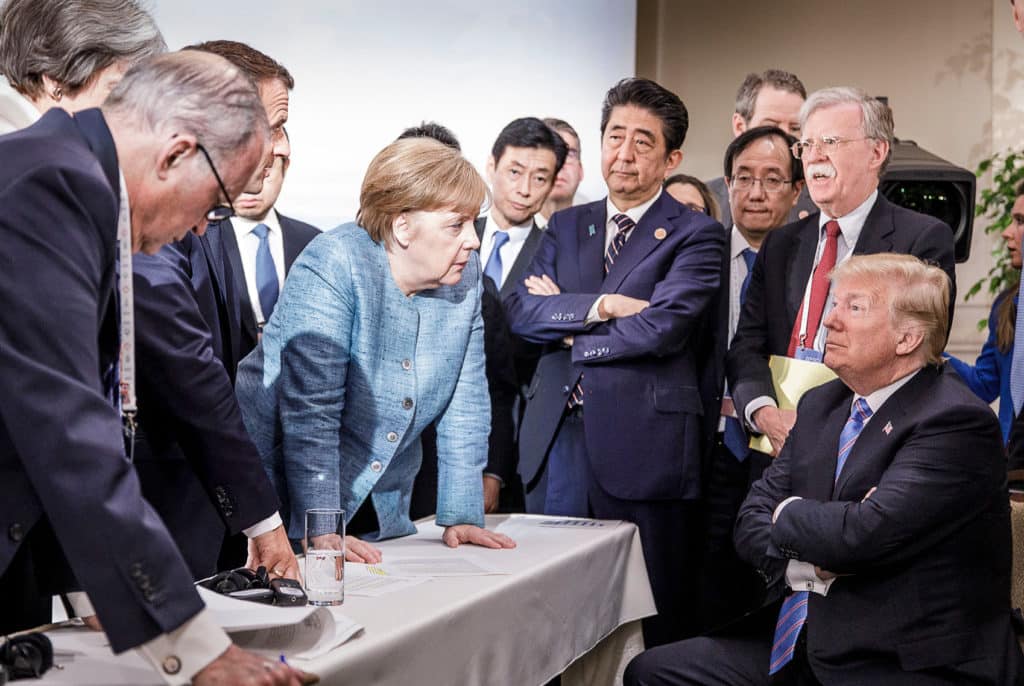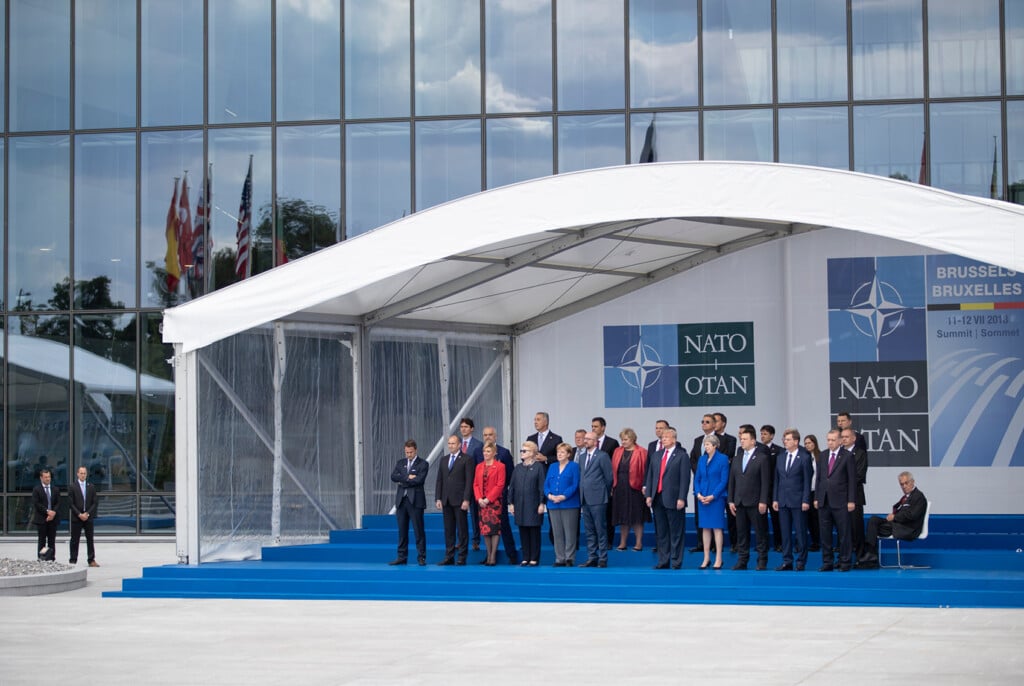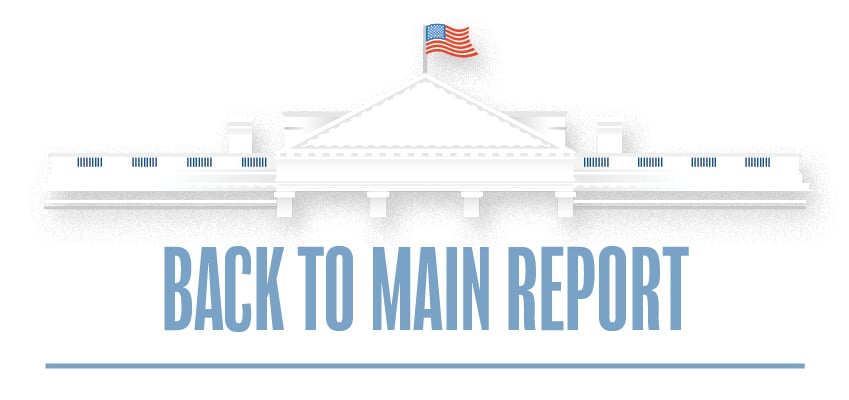January 31, 2019 |
Midterm Assessment: Europe
Contents
January 31, 2019
Midterm Assessment: Europe
Current Policy
The Trump administration has withdrawn unapologetically from two multilateral agreements – the Paris Climate Accord and the nuclear deal with Iran – that Europe’s most influential leaders consider both vital to their interests and milestones of progress toward a more cooperative world order. The White House has also clashed continuously with its European counterparts over trade policy and the sufficiency of their contributions to NATO.
These substantive disagreements have become especially acrimonious because Donald Trump has personally criticized his European counterparts in a manner once unthinkable for an American president. Trump has also created new challenges for the transatlantic alliance by raising doubts about his support for NATO’s core commitment of collective defense, describing NATO member states as freeloaders and neglecting the shared values that bind the alliance together.
Trump pledged as a candidate to withdraw the U.S. from the Paris Accord, and followed through on that promise in June 2017. French President Emmanuel Macron expressed visceral frustration with the American exit. In his address to the UN General Assembly in September 2018, Macron declared, “Let’s sign no more trade agreements with powers that don’t respect the Paris Agreement.”1
Even though Trump consistently denounced the nuclear deal with Iran as “the worst deal ever,” the State Department spent several months negotiating a set of potential amendments with the British, French, and Germans. These discussions sought to fix the deal’s biggest flaws, including inadequate verification measures, the failure to address Iran’s expanding ballistic missile program, and sunset clauses on key nuclear restrictions that expired too soon.
In May 2018, after it became clear that no transatlantic consensus would emerge on how to fix the deal, Trump pulled the U.S. out of the agreement formally known as the Joint Comprehensive Plan of Action (JCPOA). The U.S. Treasury then announced the reinstatement of all U.S. sanctions on Iran after a 180-day waiting period. In response, European leaders began to explore potential means for circumventing U.S. sanctions. These included “blocking legislation” to prevent corporations from complying with sanctions and a “special purpose vehicle” (SPV) to enable financial transactions with Tehran.
With regard to NATO, Trump has questioned whether the alliance is worth preserving and accused the other members of being delinquent, or even “captive to Russia,” in the case of Germany.2 Though he eventually endorsed the alliance’s core Article V commitment to collective defense, Trump pointedly refused to do so during his first visit to NATO headquarters in May 2017. With tensions rising, the French president called in November 2018 for the creation of a “true European army” to protect Europe, a proposal that German Chancellor Angela Merkel quickly seconded.3
On the trade front, Trump put in place steel and aluminum tariffs that apply to European imports, while the EU retaliated with import duties on U.S. goods, including motorcycles, bourbon, and blue jeans. Tensions subsided after Trump and EU Commission chief Jean-Claude Juncker reached an agreement in principle “to work together toward zero tariffs, zero non-tariff barriers, and zero subsidies on non-auto industrial goods.”4 The steel and aluminum tariffs remain in place, however.

German Chancellor Angela Merkel deliberates with U.S. President Donald Trump on the sidelines of the second day of the G7 summit on June 9, 2018 in Charlevoix, Canada. (Photo by Jesco Denzel/Bundesregierung via Getty Images)
Assessment
The Trump administration has created unprecedented tension between the U.S. and Europe. While the administration should not reverse its position on critical issues simply because Europe disagrees, the president should articulate criticism with greater nuance and appreciation for the overall importance of the transatlantic alliance to U.S. security, prosperity, and values. By standing together, the U.S. and Europe can far more effectively address the growing challenge that they both face from China.
By standing together, the U.S. and Europe can far more effectively address the growing challenge that they both face from China.
The Trump administration correctly sought to fix the nuclear deal, together with Europe, before jettisoning it. Yet the Europeans remain adamantly unwilling to take punitive actions against Iran for ballistic missile launches and related offenses, lest they jeopardize the nuclear deal. Also, since 2015, the EU has not sanctioned any additional Iranian officials for their grave human rights violations, whereas the Trump administration has designated 19 individuals and entities for their abuses. Only after Iran assassinated or attempted to assassinate opposition figures in France, Denmark, and the Netherlands did the EU impose new terrorism sanctions in January 2019.
After its withdrawal from the JCPOA, the Trump administration dealt effectively with European efforts to circumvent U.S. sanctions. European diplomats aggressively lobbied their American counterparts to keep Iran’s banks connected to the SWIFT international messaging system, since they know that as long as Iran is on SWIFT, there is a financial conduit available for conducting trade in spite of U.S. sanctions. In response to U.S. pressure, SWIFT disconnected the Central Bank of Iran and other leading financial institutions, although some remain connected for the purpose of facilitating humanitarian transactions.
Meanwhile, EU blocking legislation and related measures did not prevent the divestment of Europe’s leading multinational firms from Iran’s volatile market, including the German engineering powerhouse Siemens, French energy company Total, and massive Danish shipping enterprise Maersk.5 Executives know that the risks of being cut off from the American market and the U.S. dollar far outweigh the benefits of operating in Iran. Meanwhile, the prospects for an SPV remain uncertain. The EU claims that preparations for introducing the mechanism will continue into 2019.
Turning to NATO, four additional allies are now on track to spend 2 percent or more of GDP on defense, the binding target set by the alliance in 2014. This brings the total to eight, including the United States, which far outpaces the rest by spending more than 3 percent of GDP. Overall, America’s NATO partners have spent an additional $41 billion on defense over the past two years.6 That said, it is mostly the smaller NATO members on the Russian periphery that have moved toward the 2 percent target. The 27 non-U.S. member states still spend an average of 1.47 percent of GDP, up from 1.40 in 2014.
Operationally, despite Trump’s persistent criticism of the alliance, the U.S. continues to devote additional resources to enhance NATO’s overall capabilities to constrain and deter Russian aggression, particularly on its eastern flank. U.S. funding for the European Deterrence Initiative rose 40 percent to $4.8 billion in 2018, and the administration has requested $6.5 billion for 2019.
Finally, on trade, the EU apparently put the ill-defined Trump-Juncker deal on a slow track, perhaps waiting for a more pro-trade candidate to win the 2020 U.S. elections. Given the far greater importance of overhauling U.S. economic relations with China, the Trump administration should focus on that goal rather than pursuing disputes with European trade partners. Whereas the U.S. and Europe pursue economic competition within the framework of a rules-based global trading system, both must now contend with China’s efforts to reap the benefits of an open trading system while violating its norms.

World leaders meet for NATO summit in Brussels. (Photo by Jasper Juinen/Getty Images)
Recommendations
- Ensure the long-term viability of NATO by emphasizing its foundation of shared values. While the administration often insists that “America First” does not mean America alone, the president’s view of alliances appears to be mainly transactional, rather than values-based. At a minimum, the president should affirm unequivocally the U.S. commitment to NATO, and especially its obligation to collective defense under Article V. On the European side, the test of its commitment will be whether the larger states of Western Europe make clear progress toward the 2 percent spending target.
- Exercise careful oversight of the SWIFT humanitarian channel and continue blocking the establishment of an SPV. After SWIFT disconnected Iran’s leading banks in 2012, Iran abused the remaining humanitarian channel to restock the regime’s reserves of hard currency. The U.S. should insist that SWIFT immediately disconnect any bank that engages in such illicit conduct. Nor should the White House waver in its insistence that any institution participating in an SPV would be subject to sanctions.
- Employ sanctions and diplomacy to disrupt Hezbollah’s operations in Europe. Despite disagreements about the nuclear deal, the U.S. and Europe have a mutual interest in bringing greater pressure to bear on Iran’s most potent terrorist proxy. The U.S. should press all European countries to designate Hezbollah in its entirely as a terrorist organization, rather than allowing its so-called political wing to operate legally. The U.S. should also employ new sanctions authorities signed into law in the fall of 2018 to designate European entities and individuals that transact with Hezbollah.
- Look for opportunities to partner with European states to address other common threats. In April 2018, French and British jets joined the U.S. in launching air strikes in Syria to punish Bashar al-Assad’s use of chemical weapons. Likewise, the French and British have troops in northeast Syria, with whom the U.S. should continue working to prevent the regrowth of the Islamic State and protect local partners like the Kurds, even if the overall U.S. presence diminishes. Similarly, Europe shares many of the Trump administration’s concerns over unfair Chinese trade policies, intellectual property theft, and threats to cybersecurity.
- Resolve trade disputes amicably while moving toward the zero tariff, zero barrier, and zero subsidy goal envisioned by Trump and Juncker. The U.S. should assert its interests firmly in trade negotiations while remembering that Europe is a genuine economic partner, unlike China who manipulates commercial relations to advance its strategic and military interests at the expense of the United States.
- Maintain a substantive dialogue on climate issues. There is little prospect for a significant agreement on climate change, but the U.S. can reassure its allies that it recognizes the role of carbon emissions in rising global temperatures and will carefully balance the costs of action and inaction on climate change.
- Encourage European countries and the EU as a whole to adopt measures that prevent discriminatory boycotts against Israel. While the U.S. and Europe may disagree about certain aspects of the Israeli-Palestinian conflict, there is more common ground than recognized with regard to preventing discriminatory boycotts. For example, France has applied its robust anti-discrimination laws to limit the organizational activities of the BDS (boycott, divestment, and sanctions) movement. European governments can learn from the measures that 26 American states have put in place to hold accountable companies who support such boycotts. The EU should also clarify that anti-Israel boycotts sought by member states, such as Ireland, violate the EU’s exclusive jurisdiction over the bloc’s trade policy.
